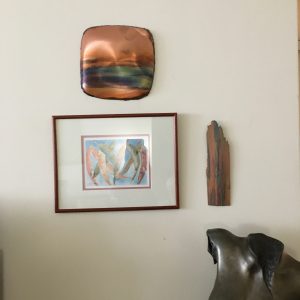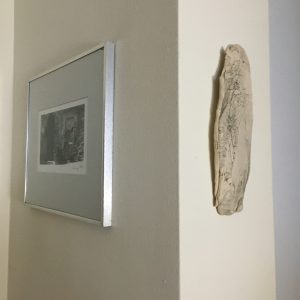You just splurged on your first original work of art at a gallery or market. Or you’ve brought home a stunning new piece to add to your growing collection. Perhaps you have moved, and as you are unpacking the boxes you realize that your art will look different in the new home. The colors of the walls are different. The windows face east rather than south. You’ve purchased some new furniture. The whole look of this home is unlike anywhere you have lived before. You find yourself wondering “where is the ideal place for hanging your art?”
When any of these events happen in my life, I give serious consideration to where my art will hang. I usually spend hours agonizing on where the nails will be placed. Sometimes art will sit on the floor for days, maybe even weeks, before it will find its rightful place on the walls. I just cannot help myself! That’s because I need to answer these six important questions before I can decide.
What is the piece of art about?
While this is the starting point – it is only that – a place to start the study of your collection.
Some art just decides for itself where it should best be placed. Our martini glass by Bernard Buffet has always found its perfect spot in the dining room of every home. Although I always enjoy a good drink at any time of the day, I cannot imagine ever taking Mr. Buffet to bed with me – so it’s always in the dining room and never the bedroom.
 By the same logic, I could not imagine trying to fall asleep with the eyes of my self-portrait glaring down on me. But that same self-portrait keeping an eye on me while I work in my studio-office reminds me that I am an artist and a writer. This is a much better location, based on the content.
By the same logic, I could not imagine trying to fall asleep with the eyes of my self-portrait glaring down on me. But that same self-portrait keeping an eye on me while I work in my studio-office reminds me that I am an artist and a writer. This is a much better location, based on the content.
This type of logic applies to nudity as well. You may love the nude body and think that if Rembrandt nudes can hang in famous art galleries then they can do the same in your home. That’s when you have to ask yourself “why” before choosing a particular location. If you chose a piece for your own enjoyment, then place it where you will enjoy it most. If you bought it to prove that you have a good eye for art, especially evocative pieces, then definitely place it where others can enjoy it too. Nonetheless, you might choose a space where they can avert their eyes if they don’t share your same joy of the old master’s style of nudity. in my opinion, I don’t think you should place erotic or controversial art in a spot where people cannot get away from it. You don’t want a situation where every time your dinner guests raise their eyes to converse with you, they are thinking: “How quickly can we finish dinner?”
Whatever attracted you to a piece of art should also be considered when you select its place to hang – whether you will share it with the world or keep it all to yourself. If you have an exceptional piece and it hangs in your bedroom (where guests rarely wander in your home), you can still invite them in for a personal viewing. In fact, maybe an art tour comes with cocktails before dinner? Perhaps art becomes the topic of an ice-breaking conversation over dinner.
How does the piece speak to you?
Is it saying something quietly, shyly, subtly? Then perhaps it needs a small corner where it can whisper at you every time you walk by. On the other hand, a soft piece sometimes needs to be part of a larger collection to make its voice heard, sort of like a very young soprano in a choir.
Does a painting make a bold statement? A large piece like our large “moonscape” would be too much for a group. Every time I look at it, I am mesmerized by the shapes. I wouldn’t want any other art form or furniture to distract me from studying the color and shape of each overlapping circle. It needs a room where you can stand back from it, or get up close to study it. These pieces generally “look their best” when hung on a wall with no furniture nearby. It can also stand alone as as a feature above a single piece of furniture like a sofa or table. This is often the case when a piece is very large or very colorful. You don’t want to distract from what it has to say. However if you are going to hang it with other art, a major piece is best balanced by a smaller or subtler piece that complements it, rather than steals the show.
If your pieces are sentimental or memorable, then place them where you will see them often. I never see the point of placing your favorite piece in a guest bedroom where it is only seen by house-guests a few times a year, or you only see it when you’re cleaning the room. It doesn’t mean that your spare room doesn’t deserve great art – just not your memorabilia, or your favorites.
And never dismiss places like the kitchen, bathroom or a hallway. The places where you spend the most are often ideal spots for you to enjoy a memory. I have my Georgia O’Keefe print hanging right beside the fridge. That way a trip for a cold one on a hot day brings back great memories of one of my favorite artists, and also of Sante Fe where I saw her exhibition.
Who should / will see the piece?
Most of the principles that you need to apply to this question were covered in the first section.
- Did you buy the art for yourself, your friends, your family or as an investment?
- Is it a classic or modern?
- Does it speak for itself or require explanation?
Theoretically, art should be admired by everyone at any time, which is why we have huge public galleries all over the world. In all likelihood you will have visitors to your home who will admire your works too. However, do you want to be explaining your erotic art prints or dark macabre originals to your six year old nephew at the next family gathering? Do you want to feel like you are seducing a friend as you lure them away to see your most valuable works hidden in the master bedroom?
Place your artwork where your guests can admire them without feeling like they are invading your privacy. This might mean just having a welcoming, open-door policy if you want to share art that’s in a bedroom or office. On the other hand, if you do own art that is intended for “your eyes only” it should remain in rooms that are considered “by invitation only”.
Will the piece be a part of a collection or is it a stand-alone?
Some pieces are too large for a collection (like our moonscape). Others are so unique or sentimental that you always want to admire them on their own without distraction. A few are absolute stand-outs in style or color that they would appear the “odd one out” if placed beside another piece. These should always have a “place of their own”, often a whole wall of their own. Perhaps you are the type of person that believes each piece of art that you own is unique and deserves its own wall. If you have the space, that works.
Even in art galleries however, items are often grouped for effect and/or because there isn’t enough space to give each its own wall. This may be the case in your own home, especially if you are a prolific collector. When you are grouping your work into a collection of any size, consider first what the commonality between the pieces is, and then how they blend. Also consider which piece will become the heart within the group.
Sometimes a collection is so eclectic that it has no cohesive element in either its art-form (original painting: oil, acrylic, water-color; photographs: black-and-white vs color, etc.) or its presentation (e.g. framing, art media, sculpture, theme, etc.). Then just go for a presentation that ensures a focal point to capture the eye’s attention.
That brings up the point again of who will view the work. Even if it is hidden away in a study or office (a room only you will ever see), make sure that the arrangement emphasizes your favorite piece. This doesn’t necessarily mean that your preferred art is always at the center of the collection. Perhaps it is at the top right or bottom left and your eye travels up or down to it.
I have several eclectic collections in my place.  The first is a series of art pieces all collected from places where I have lived. It includes photographs, wood art, pottery, posters, even postcards as well as original art. It works for me because I hang it in the hallway wherever I live. The confined viewing space highlights the art forms, as well as the content (the ten cities that I have called “home”).
The first is a series of art pieces all collected from places where I have lived. It includes photographs, wood art, pottery, posters, even postcards as well as original art. It works for me because I hang it in the hallway wherever I live. The confined viewing space highlights the art forms, as well as the content (the ten cities that I have called “home”).
 The second is a grouping based on the theme of “water”. All of the pieces are sentimental, such as the photographs that family members have taken, or a watercolor that my son did at six years old. Several are reprints of famous paintings that I bought at gift shops on my way out of the art gallery exhibitions. One is an original, where the frame was chosen to set off the artist’s style. This theme is carried over by three other pieces in the room. All three of these are originals of water, but each is given their own unique space. The sentimentality also carries through. One is my own painting. Another is an original of our beach wedding, done by a friend.
The second is a grouping based on the theme of “water”. All of the pieces are sentimental, such as the photographs that family members have taken, or a watercolor that my son did at six years old. Several are reprints of famous paintings that I bought at gift shops on my way out of the art gallery exhibitions. One is an original, where the frame was chosen to set off the artist’s style. This theme is carried over by three other pieces in the room. All three of these are originals of water, but each is given their own unique space. The sentimentality also carries through. One is my own painting. Another is an original of our beach wedding, done by a friend.

The third collection that I love is based on a unique “copper-color” scheme. Each piece reflects not only the copper tones but also the greens and blues that copper creates when oxidized. And all three are distinctive art forms in themselves – one a copper plate, the second a piece of “found” wood that I painted with food coloring, and the third is an original watercolor of gum tree leaves (painted by a friend). They come from three memorable places: Arizona, Montreal and Australia.
Be bold when placing work together. Just decide why they are similar – to you. Then when you look at them every day you don’t just see the beauty in three individual pieces that attracted you to each of them, but you also see the commonality, which is why you placed them together. In one case for me it was the colors. In another, it was the subject.
What will light do to your art?
When planning where to place your art, considering the “light” in a room is important for two reasons:
- The first is that direct light may impact the item by fading the colors or damaging it. In that case, your pieces may need to be protected from the light or encased in museum-quality glass so that they are not diminished in value, or completely destroyed.
- The second is the effect that the light has on the artistry. In some rooms, a work of art will look different at various times of the day because some types of lighting (sunshine vs. electric) will reveal more details or characteristics. On the other hand, some pieces may become more difficult to fully enjoy in a particular lighting situation. Sunlight glaring off the ordinary glass of a framed photograph may make the image hard to see. Art with shiny surfaces may not look as brilliant in a dark hallway as it would in a brightly lit room.
Selecting the best light to show off your art is like selecting a V-neck dress that accentuates your cleavage but is still modest.
From what perspective is your art best viewed?
This concept applies to both the height it is hung at, and which wall you choose.
For example, I have some low hanging pieces in a hallway that is very narrow. There is little room to stand back and admire the pieces from a distance, but I wanted them positioned so the viewer can look directly at them. Because there are many pieces, the ones that are best looked at from a distance (landscapes) are placed up high so they are further away from the eye. The smaller pieces are at or below eye-level, to ensure that a guest can see the detail without straining.
 Don’t forget about the corners or small spaces of your home. A tiny bit of wall beside a closet door can be the perfect place for a piece of pottery or driftwood art which you bought at the beach.
Don’t forget about the corners or small spaces of your home. A tiny bit of wall beside a closet door can be the perfect place for a piece of pottery or driftwood art which you bought at the beach.
Another aspect of hanging for the viewer is the choice of location within the room. To help explain this concept, I will use a personal example. I find my ‘water’ collection (described earlier) to be very relaxing. I could have hung the collection in an attractive arrangement on the main wall over the bed. However in that location it would only be viewed when entering the room – by myself or anyone else. So instead, I selected the wall at the foot of the bed. This location provides me with water views before I go to bed and in the morning as I rise. The tranquility of this art sets my mood for the day. This fits well with the concept of Feng Shui, which says that what we see – as we rise, or leave our homes to go to work – can influence our entire day. Thus, this collection was hung for my everyday, personal benefit, and not that of the occasional visitor to the room.
Art should also complement your furniture rather than compete with it. This doesn’t mean that its placement cannot accentuate your eclectic taste. It simply means you should not place pieces on or near furniture that will cause the viewer to stop and analyze the incongruity every time they walk by. You want your guests to admire both the art – and the more functional furniture – for their uniqueness, rather than seeing a clash (which often makes people uneasy). That is, unless of course your purpose is to make either the art, or your decorating style, appear intentionally provocative. Then anything goes! And, you can (and probably will) ignore everything that I have said. That works too.
The ultimate goal is to be comfortable with your choice of location. Your art should add to, rather than detract from, the relaxation that you, and your visitors, find in your home.
More tips for hanging your art
Now that you have considered where you will hang each piece of art, I suggest that you place them on the floor or on a chair (a table or box will do also) in the general area of where you have decided they will look best. Wait a day or so before hanging the art. Then if it feels right, get out the hammer and start banging those nails in the wall.
While I have given you some concepts for placement, check out this article on My Move for ideas on how to measure the exact location of your placement.
This Better Homes and Garden slideshow on How to Arrange Art for a Flawless Wall Display gives you some additonal tips for how to group or arrange your pieces when hanging them.
The Spruce agrees with me in this article Fantastic Tips for Perfectly Placed Art that you should “take the time to try out various heights and locations before you punch holes in the wall for picture hooks.” They also give good advice on how to determine eye level. In my home it is probably always lower than average because I am not quite five feet tall. But I think that is okay since I am the person most frequently admiring the art anyway.
And if you still need more inspiration check out the photos of interesting groupings in this article Everything you need to think about when hanging artwork on the Organize my Home site.
What issues do you have when trying to hang a single piece or grouping of art? What has worked best for you? What was your worst hanging experience? What advice do you have for others?